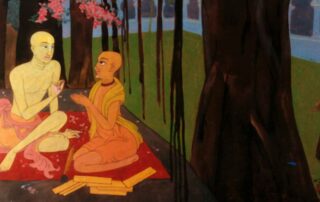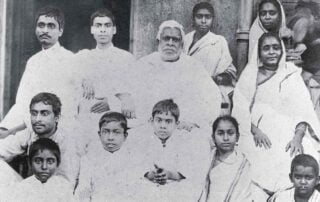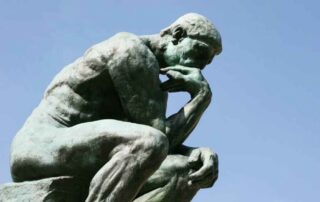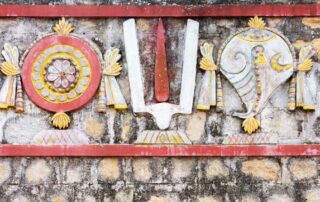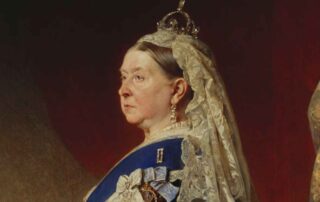Latest Posts
Here you will find all the latest posts on the Bhaktivinoda Institute in the form of Articles, Book Chapters, Songs & Poems etc.
Hari-nāma Cintāmaṇi – Chapter 2
Śrī Hari-nāma Cintāmaṇi was written in 1900 by Śrīla Bhaktivinoda Ṭhākura. This work of fifteen chapters composed in Bengali verse form, explains in detail the process of chanting the Holy Name, and especially deals with the ten offences as delineated in the Padma Purāṇa. The narrative is a dialogue between Śri Caitanya Mahāprabhu and Śrīla Hari Dāsa Ṭhākura. In the introduction, Bhaktivinoda Ṭhākura states that Hari-nāma Cintāmaṇi is based upon rare texts that he discovered during his research.
Datta Vaṁśa Mālā – Part 2
‘Datta Vaṁśa Mālā’ was written by Bhaktivinoda Ṭhākura in 1876, and is a genealogical description of his dynasty, the Dattas. The first part is a series of 32 Sanskrit verses, to which the Ṭhākura gave an expanded Bengali translation/commentary to. The second part of the book is a lengthy genealogy of the Datta dynasty that Bhaktivinoda had collected from various family sources.
Datta Vaṁśa Mālā – Part 1
‘Datta Vaṁśa Mālā’ was written by Bhaktivinoda Ṭhākura in 1876, and is a genealogical description of his dynasty, the Dattas. The first part is a series of 32 Sanskrit verses, to which the Ṭhākura gave an expanded Bengali translation/commentary to. The second part of the book is a lengthy genealogy of the Datta dynasty that Bhaktivinoda had collected from various family sources.
Datta Vaṁśa Mālā – Preface
‘Datta Vaṁśa Mālā’ was written by Bhaktivinoda Ṭhākura in 1876, and is a genealogical description of his dynasty, the Dattas. The first part is a series of 32 Sanskrit verses, to which the Ṭhākura gave an expanded Bengali translation/commentary to. The second part of the book is a lengthy genealogy of the Datta dynasty that Bhaktivinoda had collected from various family sources.
Hari-nāma Cintāmaṇi – Chapter 1
Śrī Hari-nāma Cintāmaṇi was written in 1900 by Śrīla Bhaktivinoda Ṭhākura. This work of fifteen chapters composed in Bengali verse form, explains in detail the process of chanting the Holy Name, and especially deals with the ten offences as delineated in the Padma Purāṇa. The narrative is a dialogue between Śri Caitanya Mahāprabhu and Śrīla Hari Dāsa Ṭhākura. In the introduction, Bhaktivinoda Ṭhākura states that Hari-nāma Cintāmaṇi is based upon rare texts that he discovered during his research.
Hari-nāma Cintāmaṇi – Introduction
Śrī Hari-nāma Cintāmaṇi was written in 1900 by Śrīla Bhaktivinoda Ṭhākura. This work of fifteen chapters composed in Bengali verse form, explains in detail the process of chanting the Holy Name, and especially deals with the ten offences as delineated in the Padma Purāṇa. The narrative is a dialogue between Śri Caitanya Mahāprabhu and Śrīla Hari Dāsa Ṭhākura. In the introduction, Bhaktivinoda Ṭhākura states that Hari-nāma Cintāmaṇi is based upon rare texts that he discovered during his research.
Manaḥ Śikṣā Bhāṣā
In 1886 Bhaktivinoda Thākura wrote a Bengali commentary to Śrīla Raghunātha Dāsa Gosvāmi’s Manaḥ Śīkṣā (‘Teachings to the Mind’) entitled ‘Śrī Bhajana-darpaṇa Bhāṣya’ (‘A mirror that reflects one’s bhajana’). The Ṭhākura also wrote a Bengali prose version of Manaḥ Śīkṣā.
Manaḥ Śīkṣā – Verse 12
In 1886 Bhaktivinoda Thākura wrote a Bengali commentary to Śrīla Raghunātha Dāsa Gosvāmi’s Manaḥ Śīkṣā (‘Teachings to the Mind’) entitled ‘Śrī Bhajana-darpaṇa Bhāṣya’ (‘A mirror that reflects one’s bhajana’). The Ṭhākura also wrote a Bengali prose version of Manaḥ Śīkṣā.
Manaḥ Śīkṣā – Verse 11
In 1886 Bhaktivinoda Thākura wrote a Bengali commentary to Śrīla Raghunātha Dāsa Gosvāmi’s Manaḥ Śīkṣā (‘Teachings to the Mind’) entitled ‘Śrī Bhajana-darpaṇa Bhāṣya’ (‘A mirror that reflects one’s bhajana’). The Ṭhākura also wrote a Bengali prose version of Manaḥ Śīkṣā.
Manaḥ Śīkṣā – Verse 10
In 1886 Bhaktivinoda Thākura wrote a Bengali commentary to Śrīla Raghunātha Dāsa Gosvāmi’s Manaḥ Śīkṣā (‘Teachings to the Mind’) entitled ‘Śrī Bhajana-darpaṇa Bhāṣya’ (‘A mirror that reflects one’s bhajana’). The Ṭhākura also wrote a Bengali prose version of Manaḥ Śīkṣā.
Tattva Viveka – Chapter 2
Śrīla Bhaktivinoda Ṭhākura wrote Tattva Viveka in 1893. This work, comprised of 48 Sanskrit ślokas and a detailed Bengali commentary, deals with various philosophies and religions, both eastern and western, and compares them to the precepts of the great Vaiṣṇava ācāryas.
Tattva Viveka – Chapter 1
Śrīla Bhaktivinoda Ṭhākura wrote Tattva Viveka in 1893. This work, comprised of 48 Sanskrit ślokas and a detailed Bengali commentary, deals with various philosophies and religions, both eastern and western, and compares them to the precepts of the great Vaiṣṇava ācāryas.
Śrī Acyutānanda’s Departure (Śrī Acyutānandera Niryāṇa)
In this amazing article, 'Śrī Acyutānandera Niryāṇa (Śrī Acyutānanda's Departure)' from Sajjana-toṣaṇī, Volume 7, Issue 2 from May 1895, Śrīla Bhaktivinoda Ṭhākura narrates the miraculous passing of his eldest son, Annadā Prasāda Datta, also known as Acyutānanda. In this article, Bhaktivinoda Ṭhākura writes in the third person.
Manaḥ Śīkṣā – Verse 9
In 1886 Bhaktivinoda Thākura wrote a Bengali commentary to Śrīla Raghunātha Dāsa Gosvāmi’s Manaḥ Śīkṣā (‘Teachings to the Mind’) entitled ‘Śrī Bhajana-darpaṇa Bhāṣya’ (‘A mirror that reflects one’s bhajana’). The Ṭhākura also wrote a Bengali prose version of Manaḥ Śīkṣā.
Maṅgalācaraṇa
In this short editorial entitled 'Maṅgalācaraṇa' from Sajjana Toṣaṇī, Vol.4, issue 1, Bhaktivinoda Ṭhākura invokes the blessings of Mahāprabhu and the Vaiṣṇavas, and prays for the good health of Queen Victoria, the ruler of India, so that the devotees can continue to relish and propagate pure Vaiṣṇava dharma.

